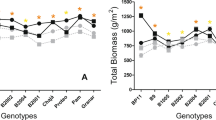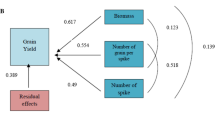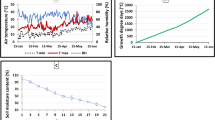Abstract
Several yield-based drought tolerance indices are in use, but their efficiencies are not well documented in plant breeding programs. I therefore examined the repeatability, similarity and accuracy of these indices under different levels of drought stress (mild, moderate, severe) in durum wheat. In a 4-year experiment (2007–2010) 24 durum genotypes (breeding lines, landraces, and old and new varieties) were evaluated under rainfed and irrigated conditions in the Dryland Agricultural Research Institute of Iran (Sararood Station). Several yield-based drought tolerance indices including stress tolerance index (STI), geometric mean productivity (GMP), mean productivity (MP), tolerance index (TOL), stress susceptible index (SSI), yield stability index (YSI) and yield index (YI) were calculated based on the different levels of stress. Discrimination among the genotypes on the basis of mean values was better under severe stress than mild stress conditions. Pearson’s correlation coefficients and Kendall’s coefficient of concordance were used to estimate the repeatability and similarity of these indices. The coefficient of variation (CV%) derived from re-sampling correlations obtained by the bootstrap method was used to quantify the predictive efficiency of drought indices. Correlations between the estimates of drought tolerance indices from different levels of stress were not highly repeatable, suggesting that a single level of stress could not serve as a basis to quantify drought tolerance in durum genotypes. MP followed by STI and GMP showed moderate repeatability with high accuracy, indicating that their efficiency in screening genotypes is not highly dependent on the nature of stress. SSI, TOL and YSI with variable concordance values were found to be inaccurate indices for identifying drought tolerant genotypes.


Similar content being viewed by others
References
Al-Yassin A, Grando S, Kafawin O, Tell A, Ceccarelli S (2005) Heritability estimates in contrasting environments as influenced by the adaptation level of barley germplasm. Ann Appl Biol 147:235–244
Atlin GN, Frey KJ (1990) Selecting oat lines for yield in low productivity environments. Crop Sci 30:556–561
Bates BC, Kundzewicz ZW, Wu S, Palutikof JP (2008) Climate change and water. Intergovernmental Panel on Climate Change, Geneva, 210 pp. www.ipcc.ch/pdf/technicalpapers/climate-change-water-en.pdf. Accessed 10 July 2013
Benmahammed A, Djekoun A, Kribaa M, Bouzerzour H (2010) Assessment of stress tolerance in barley (Hordeum vulgare L.) advanced breeding lines under semi arid conditions of the eastern high plateaus of Algeria. Euphytica 172:383–394
Bouslama M, Schapaugh WT (1984) Stress tolerance in soybean. Part 1: evaluation of three screening techniques for heat and drought tolerance. Crop Sci 24:933–937
Bruckner PL, Frohberg RC (1987) Stress tolerance and adaptation in spring wheat. Crop Sci 27:31–36
Cabello R, Monneveux P, DeMendiburu F, Bonierbale M (2013) Comparison of yield based drought tolerance indices in improved varieties, genetic stocks and landraces of potato (Solanum tuberosum L.). Euphytica 193:147–156
Ceccarelli S (1996) Positive interpretation of genotype by environment interactions in relation to sustainability and biodiversity. In: Cooper M, Hammer GL (eds) Plant adaptation and crop improvement. CABI Publishing, Wallingford, pp 467–486
Ceccarelli S, Grando S, Impiglia A (1998) Choice of selection strategy in breeding barley for stress environments. Euphytica 103:307–318
Chapman SC, Crossa J, Basford KE, Kroonenberg PM (1997) Genotype by environment interactions and selection for drought tolerance in tropical maize. II. Three-mode pattern analysis. Euphytica 95:11–20
Clarke JM, De Pauw RM, Townley-Smith TM (1992) Evaluation of methods for quantification of drought tolerance in wheat. Crop Sci 32:728–732
Collaku A (1994) Selection for yield and its components in a winter wheat population under different environment conditions in Albania. Plant Breed 112:40–46
Collaku A, Harrison SA (2005) Heritability of waterlogging tolerance in wheat. Crop Sci 45:722–727
Dodig D, Zoric M, Kandic V, Perovic D, Momirovic GS (2012) Comparison of responses to drought stress of 100 wheat accessions and landraces to identify opportunities for improving wheat drought resistance. Plant Breed 131:369–379
Donmez E, Sears RG, Shroyer JP, Paulsen GM (2001) Genetic gain in yield attributes of winter wheat in the Great Plains. Crop Sci 41:1412–1419
Eagles HA, Frey KJ (1977) Repeatability of the stability variance parameters in oats. Crop Sci 17:253–256
Efron B, Tibshirani RJ (1993) An introduction to the bootstrap. Chapman and Hall, New York
Fernandez GCJ (1993) Effective selection criteria for assessing plant stress tolerance. In: Proceedings of the international symposium on adaptation of vegetables and other food crops in temperature and water stress. Shanhua, Taiwan, pp 257–270, 13–16 August 1992
Fischer RA, Maurer R (1978) Drought resistance in spring wheat cultivars. I. Grain yield response. Aust J Agric Res 29:897–912
Gavuzzi P, Rizza F, Palumbo M, Campaline RG, Ricciardi GL, Borghi B (1997) Evaluation of field and laboratory predictors of drought and heat tolerance in winter cereals. Plant Sci 77:523–531
Guttieri MJ, Stark JC, Brien K, Souza E (2001) Relative sensitivity of spring wheat grain yield and quality parameters to moisture deficit. Crop Sci 41:327–335
Guzman C, Autrique JE, Mondal S, Singh RP, Govindan V, Morales-Dorantes A, Romano GP, Crossa J, Ammar K, Pena RJ (2016) Response to drought and heat stress on wheat quality, with special emphasis on bread-making quality, in durum wheat. Field Crops Res 186:157–165
Hockett EA, Nilan RA (1985) Genetics. In: Rasmusson DC (ed) Barley. Agronomy monograph no. 26. ASA-CSSA-SSSA, Madison, p 187–230
Hossain ABS, Sears AG, Cox TS, Paulsen GM (1990) Desiccation tolerance and its relationship to assimilate partitioning in winter wheat. Crop Sci 30:622–627
Huehn M (1996) Non parametric analysis of genotype × environment interactions by ranks. In: Kang MS, Gauch HG (eds) Genotype by environment interaction. CRC Press, Boca Raton, pp 235–271
International Grains Council, IGC (2014). http://www.igc.int/en/Default.aspx
International Pasta Organization, IPO (2013) The world pasta industry status report 2012. http://www.internationalpasta.org/index.aspx
Kendall MG (1962) Rank correlation methods, 3rd edn. Griffin, London
Kirigwi FM, Van Ginkel M, Trethowan R, Sears RG, Rajaram S, Paulsen GM (2004) Evaluation of selection strategies for wheat adaptation across water regimes. Euphytica 135:361–371
Leon J, Becker HC (1988) Repeatability of some statistical measures of phenotypic stability-correlation between single year results and multi years results. Plant Breed 100:137–142
Mohammadi R, Amri A (2013) Genotype × environment interaction and genetic improvement for yield and yield stability of rainfed durum wheat in Iran. Euphytica 192:227–249
Mohammadi R, Haghparast R, Amri A, Ceccarelli S (2010) Yield stability of rainfed durum wheat and GGE biplot analysis of multi-environment trials. Crop Pasture Sci 61:92–101
Mohammadi R, Sadeghzadeh D, Armion M, Amri A (2011) Evaluation of durum wheat experimental lines under different climate and water regime conditions of Iran. Crop Pasture Sci 62:137–151
Munoz P, Voltas J, Igartua E, Romagosa I (1998) Changes in adaptation of barley releases over time in north eastern Spain. Plant Breed 117:531–535
Nouri A, Etminan A, Teixeira daSilva JA, Mohammadi R (2011) Assessment of yield, yield-related traits and drought tolerance of durum wheat genotypes (Triticum turgidum var. durum Desf.). Aust J Crop Sci 5:8–16
Nyquist WE, Baker RJ (1991) Estimation of heritability and prediction of selection response in plant populations. Crit Rev Plant Sci 10:235–322
Pswarayi A, Van Eeuwijk FA, Ceccarelli S, Grando S, Comadran J, Russell JR et al (2008) Barley adaptation and improvement in the Mediterranean Basin. Plant Breed 127:554–560
Rizza F, Badeck FW, Cattivelli L, Lidestri O, Di Fonzo N, Stanca AM (2004) Use of a water stress index to identify barley genotypes adapted to rainfed and irrigated conditions. Crop Sci 44:2127–2137
Robert N (2002) Comparison of stability statistics for yield and quality traits in bread wheat. Euphytica 128:333–341
Rosielle AA, Hamblin J (1981) Theoretical aspects of selection for yield in stress and non-stress environment. Crop Sci 21:943–946
Shakhatreh Y, Kafawin O, Ceccarelli S, Saoub H (2001) Selection of barley lines for drought tolerance in low-rainfall areas. J Agron Crop Sci 186:119–127
Siegel S (1956) Nonparametric statistics for the behavioral science. McGraw-Hill, New York
Sio-Se-Mardeh A, Ahmadi A, Poustini K, Mohammadi V (2006) Evaluation of drought resistance indices under various environmental conditions. Field Crops Res 98:222–229
Sprent P (1989) Applied nonparametric statistical methods. Chapman and Hall, London
Ud-Din N, Carver BF, Clutter AC (1992) Genetic analysis and selection for wheat yield in drought-stressed and irrigated environments. Euphytica 62:89–96
Virk DS, Chahal SS, Pooni H (1985) Repeatability of stability estimators for downy mildew incidence in pearl millet. Theor Appl Genet 70:102–106
Wassmann R, Jagadish SVK, Sumfleth K, Pathak H, Howell G, Ismail A, Serraj R, Redoña E, Singh RK, Heuer S (2009) Regional vulnerability of climate change: impacts on Asian rice production and scope for adaptation. Adv Agron 102:91–133
Yadav OP, Bhatnagar SK (2001) Evaluation of indices for identification of pearl millet cultivars adapted to stress and non stress conditions. Field Crops Res 70:201–208
Yau SK, Ortiz-Ferrara G, Srivastava JP (1991) Classification of diverse bread wheat-growing environments based on differential yield responses. Crop Sci 31:571–576
Acknowledgments
This research was a part of the Regional Durum Wheat Research Project of the Dryland Agricultural Research Institute of Iran and was supported by the Agricultural Research, Education and Extension Organization (AREEO). The author wish to thanks two anonymous reviewers and the Associate Editor (Dr. Robert McIntosh) for valuable comments, corrections and suggestions on the manuscript.
Author information
Authors and Affiliations
Corresponding author
Rights and permissions
About this article
Cite this article
Mohammadi, R. Efficiency of yield-based drought tolerance indices to identify tolerant genotypes in durum wheat. Euphytica 211, 71–89 (2016). https://doi.org/10.1007/s10681-016-1727-x
Received:
Accepted:
Published:
Issue Date:
DOI: https://doi.org/10.1007/s10681-016-1727-x




